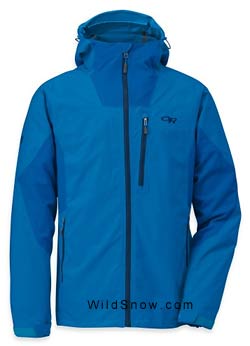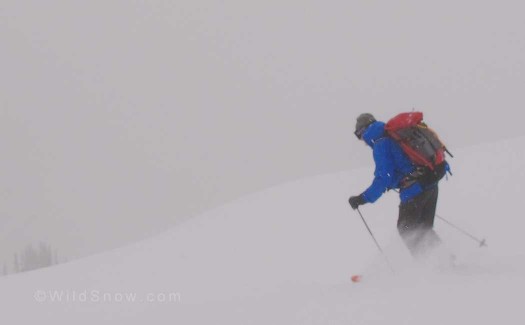I can’t get away from it. Ever since I ran a Schoeller fabric softshell as my top layer, I’ve delighted in the way such high-tech layers protect me from the weather yet yield gusty breathability without fiddly venting. So every winter I make sure I’ve got some sort of soft shell on the rack. I grab the softie when backcountry skiing conditions dictate (dry Colorado cold or good spring weather, I leave it home when I need a full-on storm shell). This winter’s choice: Outdoor Research Enchainment.

Enchainment jacket by OR
But this isn’t your grandmother’s softshell. In days of yore, to make a softshell they just stiched up a jacket made of all the same fabric. If they used some variety of Schoeller such coats worked well, but why not improve on things? To that end, underarm areas and a panel on the shoulders of the Enchainment are body mapped with a Schoeller fabric they coated with something called NanoSphere. This stuff is super breathable but still repels water well due to some sort of unobtanium “nano” coating on the outside. (Schoeller also claims “substances as ketchup, honey, coffee or red wine” just “run off” NanoSphere, which is a useful quality when you’re at a mountain hut, though one has to wonder what happens when the wine runs off the NanoSphere onto the adjacent fabric.)
Beyond the NanoSphere panels, OR builds the Enchainment with a stretchy yet tightly woven fabric that appears quite similar to Schoeller Dryskin softshell fabric — a stretchy double-weave version of the Schoeller fabric we’ve all come to love, if not worship, as some of the best stuff going for cradling your corpus while ski touring. The nameless fabric is seam taped to the NanoSphere at most junctures, but seam tape is oddly lacking on one large seam around the back area. My theory: the untaped area rides under your backpack, and what happens under your backpack regarding moisture — well, lets just say “what happens under your backpack stays under your backpack.” Thus seam taping in that area is probably an exercise in futility, and thus can be left out to save a bit of cost. To be fair, seam tape also reduces stretchability so perhaps that’s the design philosophy reason it was left out. In the end, seam tape in a soft shell is probably only necessary on the shoulder areas, so whatever.
Cons:
– Hood barely fits over helmet.
– Waist pockets that end up under pack belt (I guess these are for city folks who use softshells for hanging out at Starbucks.)
– Both of the Napolean pockets could be larger.
– Sleeves are cut slightly skinny for use over puffy, and that’s with my chicken arms.
Features I like:
– Simplicity! No fiddly pit zips!
– Hood fits well, maleable wire brim works.
– Sleeve and waist lengths are backcountry real.
– Enchainment does have two chest pockets, one inside and one outside.
– All the stretchy fabric has a pleasant feel.
– Torso sized nicely, fits over puffy without binding.
– Weight of 19.8 oz (large) is good for a softshell (I have an older one that weighs about an ounce more).
Over the past few weeks I’ve done real-world testing of the Enchainment in the types of conditions I like for a softshell. For example, cold dry Canadian weather at Rogers Pass. Conclusion: Enchainment gives me exactly what I want in a softshell. No more, no less. It’s there. On my closet rod. Beckoning me to leave that bulky noisy hard shell at home, grab the Enchainment, and go for some cold dry powder in the deep of winter.
Shop for it (possibly on sale)
WildSnow.com publisher emeritus and founder Lou (Louis Dawson) has a 50+ years career in climbing, backcountry skiing and ski mountaineering. He was the first person in history to ski down all 54 Colorado 14,000-foot peaks, has authored numerous books about about backcountry skiing, and has skied from the summit of Denali in Alaska, North America’s highest mountain.

